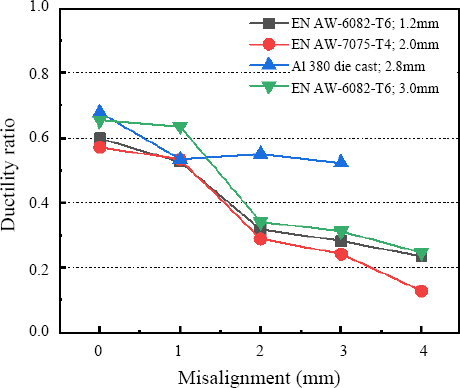1. J.H. Kim, H. U. Jun, J. Y. Cheon, Y. D. Kim, and C. Ji, Effect of the Melting Behavior of the Coating Layer on Weldability in the Bolt Projection Resistance Welding of Al-Si Coated Hot-Stamped Boron Steel,
J. Weld. Join. 38(1) (2020) 33ŌĆō40. https://doi.org/10.5781/JWJ.2020.38.1.3
[CROSSREF] 2. H.U. Jun, J. H. Kim, J. Y. Cheon, Y. G. Kim, Y. D. Kim, and C. Ji, The Effect of Pre-Welding on Nugget Growth Behavior and Weldability for the Resistance Spot Welding of A6014 - T4 Alloy,
J. Weld. Join. 38(2) (2020) 203ŌĆō210. https://doi.org/10.5781/JWJ.2020.38.2.11
[CROSSREF] 3. H.U. Jun, J. H. Kim, J. W. Kim, E. K. Lee, E. KY, D. Kim, and C. Ji, Effect of Electrode Patterning on Melting Behavior and Electrode Degradation in Resistance Spot Welding of A6014-T4 Alloy,
Korean J. Met. Mater. 58(12) (2020) 863ŌĆō874. https://doi.org/10.3365/KJMM.2020.58.12.863
[CROSSREF] 4. E.. Unel and E. Taban, Properties and optimization of dissimilar aluminum steel CMT welds,
Weld World. 61 (2017) 1ŌĆō9. https://doi.org/10.1007/s40194-016-0386-9
[CROSSREF] 5. M. Meinhardt, M. Endres, M. Graf, M. Lechner, and M. Merklein, Analysing resistance element welding with upset auxiliary joining steel-elements under shear load,
Procedia Manuf. 29 (2019) 329ŌĆō336. https://doi.org/10.1016/j.promfg.2019.02.145
[CROSSREF] 6. Z. Ling, Y. Li, Z. Luo, Y. Feng, and Z. Wang, Resistance Element Welding of 6061 Aluminum Alloy to Uncoated 22MnMoB Boron Steel,
Mater. Manuf. Process. 31 (2016) 2174. https://doi.org/10.1080/10426914.2016.1151044
[CROSSREF] 7. S.M. Manladan, F. Yusof, S. Ramesh, Y. Zhang, Z. Luo, and Z. Ling, Microstructure and mechanical properties of resistance spot welded in welding-brazing mode and resistance element welded magnesium alloy/austenitic stainless steel joints,
J. Mater. Process. Technol. 250 (2017) 45. https://doi.org/dx.doi.org/10.1016/j.jmatprotec.2017.07.006
[CROSSREF] 8. Y.H. Oh, H. J. Ryu, T. Kim, M. Choi, and T. Lee, Mechanical Performance and Microstructure of Resistance Element Welds of Dissimilar Metals Created with a Headless Rivet,
Korean J. Met. Mater. 57(11) (2019) 708ŌĆō714. http://dx.doi.org/10.3365/KJMM.2019.57.11.708
[CROSSREF] 9. EN ISO 18278-2 Resistance welding - Weldability - Part 2:Alternative procedures for the assessment of sheet steels for spot welding. (2004)
10. EN ISO 14273 Resistance welding - Destructive testing of welds - Specimen dimensions and procedure for tensile shear testing resistance spot and embossed projection welds.
11. EN ISO 14272 Resistance welding - Destructive testing of welds - Specimen dimensions and procedure for cross tension testing resistance spot and embossed projection welds.
12. J.D. Lee, S. J. Lee, J. H. Bang, D. C. Kim, M. J. Kang, M. S. Kim, and J. K. Kim, Mechanical Behavior of Weldbond Joint of 1.2 GPa Grade Ultra High Strength TRIP Steel for Car Body Applications,
J. Weld. Join. 32(5) (2014) 474ŌĆō479. http://dx.doi.org/10.5781/JWJ.2014.32.5.44
[CROSSREF] 13. J. Lim, Prediction of Tensile Shear and Cross Tension Strengths for Spot Welds of Automotive Steel Sheets, Trans. KSAE. (2010) 2760ŌĆō2765.
14. J. Wang, H. P. Wang, F. Lu, B. E. Carlson, and D. R. Sigler, Analysis of Al-steel resistance spot welding process by developing a fully coupled multi-physics simulation model,
Int. J. Heat Mass Transf. 89 (2015) 1061ŌĆō1072. http://dx.doi.org/10.1016/j.ijheatmasstransfer.2015.05.086
[CROSSREF] 15. K.C. Kim, K. H. Lee, and R. W. Chang, Resistance Spot Weldability of Cold Rolled HT80 Grade Steel for Automobile Application, J. Korean Weld. Join. Soc. 10(1) (1992) 52ŌĆō59.
16. R. Ashiri, H. Mostaan, and Y. D. Park, A Phenomeno- logical Study of Weld Discontinuities and Defects in Resistance Spot Welding of Advanced High Strength TRIP Steel,
Metall. Mater. Trans. A. 49(12) (2018) 6161ŌĆō6172. http://doi.org/10.1007/s11661-018-4900-0
[CROSSREF] 17. K. Taniguchi, H. Matsuda, R. Ikeda, and K. Oi, Heat distribution in welds by short-time high-current post- eating and its improving effect on cross tension strength:development of resistance spot welding with pulsed current pattern for ultrahigh-strength steel sheets,
Weld. Int. 30(11) (2016) 817ŌĆō825. http://doi.org/10.1080/09507116.2016.1142194
[CROSSREF] 18. P.H. Thornton, A. R. Kraus, and R. G. Davies, Contact resistance in spot welding, Weld. J. 75(12) (1996) 402ŌĆō412.












 PDF Links
PDF Links PubReader
PubReader ePub Link
ePub Link Full text via DOI
Full text via DOI Download Citation
Download Citation Print
Print



